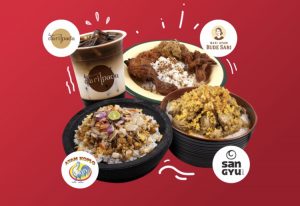It all began with Fintech. Abraham Viktor and Robin Tan gained their first startup experience with Taralite, a peer-to-peer lender, while Andreas Resha was vice president of Cermati, a financial services aggregator.
The three met when they joined Ovo, one of Indonesia’s biggest electronic payment service providers. Even though the work there appeared to be impactful and sometimes even glamorous, it wasn’t exactly what they were looking for.
“We felt that our calling was to form a startup together,” said Viktor, who is now Hangry’s CEO, in a recent interview with KrASIA. “We brainstormed on a lot of ideas, before eventually realizing that what we were passionate about was something that’s right in front of our faces: Food.”
Being food enthusiasts, the three wanted to start brands with the potential to go global, and supported by technology. They observed in the Indonesian market a new generation of tech-savvy and mobile-first consumers that are open to a different food and beverages (F&B) experience.
For decades, the Indonesian F&B industry has been dominated by conventional restaurants. The big players were large brands, already established for years, with hundreds of outlets across the country. Before, new players needed to invest a lot of money to build outlets, for promotions and other services. But Viktor, Resha, and Tan had something different in mind—a virtual restaurant.
This type of restaurant doesn’t have a dine-in area and focuses solely on delivery orders, thus cutting the operational cost. “We believe that we can also bring fast, efficient, cost-effective, and tasty food to the mass market,” said Viktor.
One app – multiple brands
In September 2019, they established Hangry, with the four in-house brands Kopi Dari Pada (coffee and milk drinks), San Gyu (Japanese beef bowl), Bude Sari (Indonesian traditional chicken dishes), and Ayam Koplo (American fried chicken served with Indonesian chili sauce).
All dishes can only be ordered online through the Hangry app, or food delivery platforms such as GrabFood or GoFood. The meals will be sent from the outlet that’s nearest to the customers’ location. Hangry currently operates 18 shops across Jakarta and its satellite cities.

Unlike most restaurants, Hangry decided to offer various foods under different brands to cater to diverse customers with individual preferences. “We want to accompany people’s moments and memories—from breakfast, coffee time, lunch, snack time, dinner, all the way to supper,” said Viktor. “Having more than one brand helps us to get there.”
This decision was also supported by extensive research prior its launch. Japanese food, chicken dishes, and iced coffee are all very popular in Indonesia and Hangry provides them all. It resulted in tremendous success. Viktor said they sold thousands of dishes per day in the first five months, with each brand rated 4.7 out of 5 on all delivery platforms.
Delighting through quality
Hangry is facing tough competition from big restaurants who digitalized their service by creating delivery apps and from other restaurants on the online food platforms. In order to beat them, Hangry has to provide a satisfying customer experience—from ordering to complaints—and high food quality.
“As a virtual restaurant player, the interesting challenge for us is to delight our customers without having the ability to please them with a nice restaurant ambience, nice atmosphere, good music, and so on,” said Viktor. “We can only delight them with our product quality, both food and app.”
Read this: As Indonesians order their iced lattes online, coffee chains start selling them in bulk
With data collected from customer feedback and preferences, Hangry continues to improve the quality and taste of the existing menu, adding more variety, and preparing a menu for new brands.
Viktor saw the huge potential of the digital restaurant business, as Indonesia’s internet economy is projected to be USD 133 billion in 2025. Even though the number might be changing due to the COVID-19 impact, Hangry is gaining momentum.
Right now, as restaurants are closed due to physical distancing measures, delivery businesses are thriving. Hangry profits from the change in behavior, where online communication has become an essential part of people’s lives, driving them to food apps.
To make things even better, the team recently received USD 3 million in seed funding from Sequoia India’s accelerator program Surge, Indonesian venture capital Alpha JWC, and angel investors. Hangry is also part of Surge’s third cohort.
What next?
With new money and new knowledge, the founders plan to expand Hangry’s geographical reach to fully cover Indonesia by the end of 2021. “This means we will keep on opening outlets in areas where we don’t have a presence yet. As long as there are pockets of people in residential or office areas, we will be there,” said Viktor.
The team also plans to integrate various point-of-sales service providers into the app and build an internal supply chain system to strengthen its delivery service. Then, from 2022, the three will cross the final frontier—and expand outside Indonesia.
Featured photo left to right: Abraham Viktor, Robin Tan, and Andreas Resha. Photo courtesy of Surge.
This article is part of KrASIA’s “Startup Stories” series, where the writers of KrASIA speak with founders of tech companies in South and Southeast Asia.

